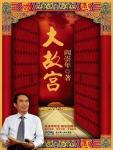Chapter 1 preface
The idea of speaking about "The Great Forbidden City" on CCTV's "Hundreds of Forums" and publishing "The Great Forbidden City" at the same time has been brewing for many years.It wasn't until the end of 2010 that we reached a consensus with friends such as Nie Congcong and Na Ersu, the producer of "Hundred Schools Forum", deputy editor-in-chief Jin Lihong, and deputy director Li Bo of Changjiang Literature and Art Publishing House.Since the beginning of 2011, I have devoted myself to data collection, field investigation, writing manuscripts and TV recording and broadcasting.At the time of writing this article, it was early 2012, and I was thinking about it. For a whole year, the first 20 episodes of "The Forbidden City" will be broadcast, and "The Forbidden City" (volume 1) will be published soon.
One of the characteristics of "The Forbidden City" is "big".The "Twelve Emperors of the Qing Dynasty", which I talked about, used the life trajectories of the twelve emperors of the Qing Dynasty as clues to tell the history of the Qing Dynasty around the mysterious cases of the Qing Palace; Taking Yuan Chonghuan as a typical character, it only involves the history of the 60 years between the first and second years of the Ming and Qing Dynasties; the "Kangxi Emperor" I talked about is more simple, which takes the life trajectory of Emperor Kangxi as the longitude line and historical events as the latitude line , about the sixty-one-year history of the Kangxi Dynasty.The above three series all belong to the category of history.But this time, "The Forbidden City" is different. It not only covers history, but also involves architecture, cultural relics, philology, archives, art, gardening, planning, the Forbidden City and Manchuria; and the time span is nearly Six hundred years, the content involves history, people, time, architecture, cultural relics, palaces, gardens, art, etc., in all aspects, all kinds of things, too big and too complicated.
I am self-aware.Inside and outside the Forbidden City, there are many experts.Ancient architecture, I am not as good as an expert on ancient architecture; utensils, I am not as good as an expert on utensils; calligraphy and painting, I am not as good as an expert on calligraphy and painting; documents, I am not as good as an expert on literature;However, to use the platform of "Hundreds of Lectures" to comprehensively tell about "The Forbidden City", to inherit and promote the essence of Chinese civilization, someone must do it!But why should I do it?
After thinking about it, things have yin and yang.Difficulties belong to Yin, and solutions to difficulties belong to Yang.Importantly, I have a supportive academic team behind me to help me out.Mr. Zheng Xinmiao, former director of the Palace Museum, president of the Forbidden City Society of China and colleagues of the society, Mr. Shan Jixiang, director of the Palace Museum and expert of the Palace Museum, Mr. Tan Weike, president of the Beijing Academy of Social Sciences and colleagues of the academy, and Mr. Chen Lihua, honorary president of the Beijing Academy of Manchuria Colleagues from the Cum Institute, as well as Jin Hongkui (former vice president of the Palace Museum, expert on ancient architecture), Chen Lihua (deputy president of the Palace Museum, expert on court historical relics), Lu Zhou (director and professor of the National Heritage Center of Tsinghua University), Qin Guojing ( Former deputy curator of the First Historical Archives of China, expert in court archives), Qian Xiaoyun (former editor of the Palace Museum Journal), Zuo Yuanbo (researcher at the Research Office of the Palace Museum), Jin Weidong (researcher at the Painting and Calligraphy Department of the Palace Museum) , and Feng Naien (Director of the Office of the Palace Museum), Huang Ximing (Expert of the Department of Ancient Architecture of the Palace Museum), Zhou Gongxin (Director of the National Palace Museum in Taipei), Feng Mingzhu (Deputy Director of the National Palace Museum in Taipei), Zhang Yonghe (famous playwright) and other friends , They enthusiastically assisted and made it possible.
As far as I am concerned, I used to be the executive director and secretary-general of the Ancient Capital Society of China, inspecting and understanding many historical ancient capitals; the executive director and secretary-general of the Beijing History Research Association, visited and studied the history and cultural relics of Beijing; Chairman, has a new perspective and new research on the Ming and Qing Forbidden City; works in the Institute of History and Manchu School of Beijing Academy of Social Sciences, and research topics are mostly related to the Forbidden City; learning the history of the Ming and Qing Dynasties, the "Great Forbidden City" is exactly the Ming and Qing Dynasties A focus of historical research and attention; being the vice president of the Chinese Forbidden City Society has given me more opportunities to visit, understand, study, and research the Forbidden City.The above experience and knowledge are not my capital, but they gave me responsibility, confidence, courage and strength to speak about "The Forbidden City".

